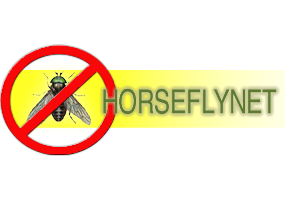-
 The effect of hay net design on rate and amount of forage consumed by adult horses
The effect of hay net design on rate and amount of forage consumed by adult horsesK. Martinson, E. Glunk and W. Weber
Description of the problem
“Horses have evolved to consume several small forage-based meals throughout the day, often spending greater than 14.5 hours grazing each day. However, many of today’s horses are housed in boxstalls or drylots, fed two large meals each day, and have limited opportunity to forage. To mimic a more natural feeding pattern many horse owners provide unlimited access to hay. In many cases, this results in obesity because the horses tend to consume hay in excess of their energy requirement. Therefore, it is of interest to identify feeding methods that reduce excess intake, but extend the foraging period beyond a few hours around meal time.
To investigate the effect of hay net design on the rate and amount of forage consumed by adult horses.
Materials and methods
Eight adult horses in were fed in individual boxstalls. Horses were fed hay off the boxstall floor (control), or from one of three hay nets: large net (6 inch openings), medium net (1.75 inches) and small net (1.0 inch). Horses were acclimated to their assigned treatment for 2 days, followed by 3 days of data collection, and a wash-out period of 2 days. Horses had access to hay inside the nets for two 4hour periods: 7:00 to 11:00 am and 4:00 to 8:00 pm each day. Throughout the trial, grass hay was fed at 1% body weight twice each day. To determine forage consumption rate, stopwatches were started once horses began eating, and stopped once horses either finished all offered hay, were no longer interested in eating, or the 4 hour time period had expired. All refuse hay was collected and weighed. Total forage consumed was calculated by subtracting amount of refuse from hay offered.
Results
Mean consumption rates were 3.3, 2.9, 2.4, and 1.9 pounds per hour for the control, large net, medium net and small net respectively. Horses were able to consume all hay from the control and large during the 4hour feeding period, but not all horses finished the hay meal when fed from the medium and small nets. Mean percentage of offered hay consumed was 95, 95, 89 and 72% for the control, large net, medium net and small net, respectively. A second study revealed that horse feeding from the medium net took just over 5 hours to consume the hay meal, while horses eating from the small nets took 6.5 hours to consume the meal. Both the control and large net resulted in consumption times of 3.2 and 3.4 hours, respectively.
Benefits to the equine industry
These results demonstrate that the small or medium nets were effective in decreasing rate and amount of forage consumed and increasing the total time of forage consumption by adult horses. If small or medium hay nets were used for twice daily feedings in a boxstall setting, the anticipated amount of time horses would spend foraging would be 10 to 13 hours each day; more closely mimicking a horse’s natural grazing behavior. Small and medium hay nets represent simple and affordable management tools for extending foraging time when meal feeding horses. However, use of the small and medium hay nets is not likely practical for all horses and it does take time (usually 4 to 5 feedings) for horses to acclimate to feeding from the nets.”
This study was done by the University of Minnesota Extension Service and available on their web site.
Feeding Hay slowly to Mimic Grazing
Call Us at (910) 725-2115 or Email Us at info@horseflynet.com
Horse Fly Net
This see-through breathable screen will last for years. It is made of polyester vinyl coated and heat sealed on the edges with brass grommets about every foot. It has no chemicals added. Our HorseFlyNets only cost approximately $2.00 a square foot for smaller sizes and less for larger. Our product is woven and manufactured in the USA.
HorseFlyNet®
Southern Pines, NC
(910) 725-2115
info@horseflynet.com


